
Danainae is a subfamily of the family Nymphalidae, the brush-footed butterflies. It includes the Daniadae, or milkweed butterflies, who lay their eggs on various milkweeds on which their larvae (caterpillars) feed, as well as the clearwing butterflies (Ithomiini), and the tellervini.

The Nymphalidae are the largest family of butterflies, with more than 6,000 species distributed throughout most of the world. Belonging to the superfamily Papilionoidea, they are usually medium-sized to large butterflies. Most species have a reduced pair of forelegs and many hold their colourful wings flat when resting. They are also called brush-footed butterflies or four-footed butterflies, because they are known to stand on only four legs while the other two are curled up; in some species, these forelegs have a brush-like set of hairs, which gives this family its other common name. Many species are brightly coloured and include popular species such as the emperors, monarch butterfly, admirals, tortoiseshells, and fritillaries. However, the under wings are, in contrast, often dull and in some species look remarkably like dead leaves, or are much paler, producing a cryptic effect that helps the butterflies blend into their surroundings.

The superfamily Papilionoidea contains all the butterflies except for the moth-like Hedyloidea.

The Satyrinae, the satyrines or satyrids, commonly known as the browns, are a subfamily of the Nymphalidae. They were formerly considered a distinct family, Satyridae. This group contains nearly half of the known diversity of brush-footed butterflies. The true number of the Satyrinae species is estimated to exceed 2,400.

Danaus affinis, the Malay tiger, mangrove tiger or swamp tiger, is a butterfly found in tropical Asia. It belongs to the "crows and tigers", the danaine group of the brush-footed butterflies family.

The Satyrini is one of the tribes of the subfamily Satyrinae. It includes about 2200 species and is therefore the largest tribe in the subfamily which comprises 2500 species.
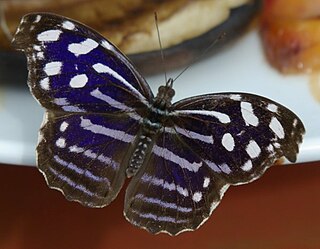
Biblidinae is a subfamily of nymphalid butterflies that includes the tropical brushfoots. This subfamily was sometimes merged within the Limenitidinae, but they are now recognized as quite distinct lineages. In older literature, this subfamily is sometimes called Eurytelinae.
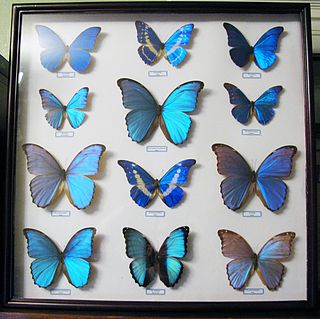
The Morphinae are a subfamily of Nymphalidae butterflies that includes the morphos, the owl butterflies (Caligo), and related lineages. It is either considered a sister group of the Satyrinae, or disassembled and included therein.

Lasiommata megera, the wall or wall brown, is a butterfly in the family Nymphalidae. It is widespread in the Palearctic realm with a large variety of habitats and number of generations a year.
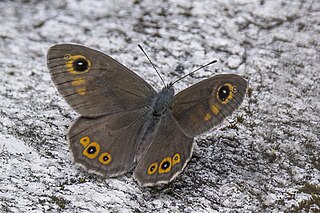
Lasiommata maera, the large wall brown, is a butterfly in the family Nymphalidae.

Lasiommata petropolitana, the northern wall brown, is a butterfly species belonging to the family Nymphalidae. It can be found in large parts of Europe, from the Pyrenees and Alps up to Scandinavia and Finland, east to Russia and Siberia.

Libythea labdaca, the African snout butterfly, is a member of the butterfly subfamily Libytheinae found in western and central Africa.

Oeneis glacialis, the Alpine Grayling, is a butterfly of the family Nymphalidae. It is found in the Alps at heights of 1400 to 2900 m above sea level.
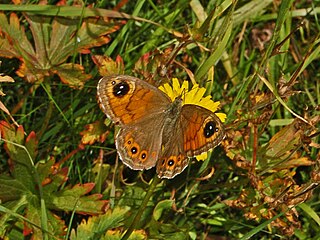
Lasiommata is a genus of butterflies of the subfamily Satyrinae in the family Nymphalidae.
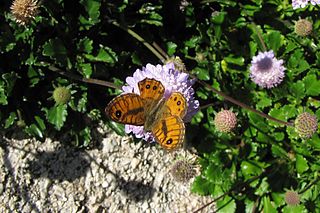
Lasiommata paramegaera, the pale wall brown or Corsican wall brown, is a butterfly species belonging to the family Nymphalidae. It is endemic to Corsica and Sardinia. The wingspan is 36–40 mm. The upper and undersides of the fore and hind wings are orange brown, they have a dark brown grid-like pattern. The females are often a little lighter colored. Near the apex of the forewing sits a white centred black eye-spot. Between this eye-spot and the outermost apical tip of the fore-wing is another very small black round spot. In the disc region of the top of the forewing, the male has a distinct scent-mark. The upperside of the hind wings has cells 1c, 2, 3, and 4 of the postdiscal region with small black, white-pupilled eye spots on. The underside of the forewings is orange-brown, the underside of the hind wings light brown. On the front wing, the underside pattern corresponds to the upperside. However, the eye spot in the apex is also surrounded by a brown ring.
Lasiommata felix, the Arabian wall brown, is a butterfly in the family Nymphalidae. It is found in south-western Saudi Arabia and Yemen. The habitat consists of the western escarpment of the Arabian Peninsula.















